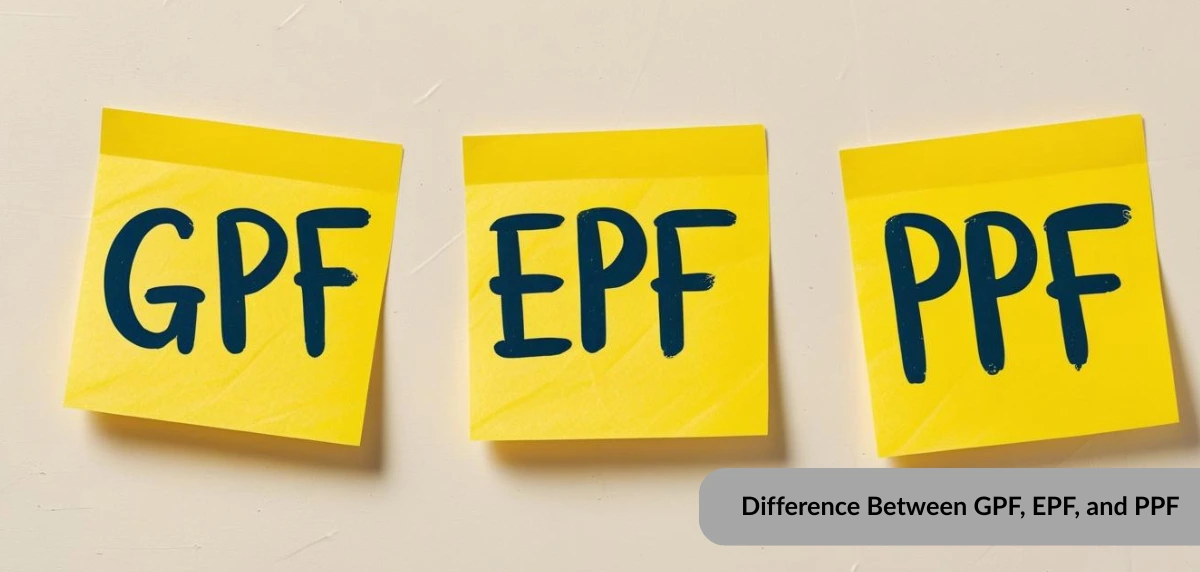The habit of saving starts the moment someone begins to receive income. Are you earning regularly? If so, you are probably familiar with provident funds. Many find the abbreviation PF unwelcome, given the deductions on their monthly salary. Yet over time, this fund can become a vital resource for financial stability and support.
If you are already aware of what provident funds offer, you probably appreciate why it matters and know the importance of having more clarity on its types. This guide is made for prudent earners seeking smarter ways to manage their salary. One helpful angle is to understand the difference between GPF, EPF, and PPF, explore the concept of GPF vs EPF vs PPF, and learn why each option can suit different circumstances.
General Provident Fund (GPF)
GPF is a retirement savings plan typically available only to government employees. Under GPF, you consistently allocate a portion of your pay until you opt to retire.
As a rule, you must contribute at least six percent of your salary. Naturally, you can choose to put in more if your budget allows. If you encounter a suspension of duty or decide to retire, you may pause your contributions. In cases of retirement, remember to stop depositing three months before your final working day. The remaining formalities follow guidelines set by the GPF scheme.
GPF Eligibility and Guidelines**
GPF is restricted to individuals employed by government agencies. If you are on a temporary posting with a steady government appointment for one year or more, you too can join. Pensioners who return to a government role can also participate (unless they already qualify for a separate contributory provident plan).
Moreover, GPF accumulates interest that is declared by the government each year. This interest is credited to your account annually, allowing your savings to grow steadily. You can also take loans against your GPF balance under defined rules. For instance, you may borrow a percentage of your accumulated sum during emergencies and repay it over a specified period. Contributions and interest earned under GPF are exempt from income tax. Additionally, upon retirement, the entire corpus (both principal and interest) is paid out as a lump sum, supporting your post-retirement needs.
In summary, government staff can rely on GPF as a dependable retirement vehicle.
Public Provident Fund (PPF)
Unlike GPF, this plan is open to all Indian residents. It offers long-term savings with attractive returns, but it requires disciplined contributions over many years.
You can make up to twelve deposits each year. Each deposit must not be less than ₹500. While you may choose to contribute more, the annual maximum is ₹1.5 lakh. A significant point is that the government adjusts the interest rate quarterly, ensuring your savings stay competitive. When you use a PPF calculator, you can project how your account will grow over its fifteen-year term, helping you set realistic targets.
Currently, the interest rate for a PPF account is 7.1 per cent per annum. The interest calculation uses the lowest balance between the fifth and last day of every month. Deposits made after the fifth day until the end of that month do not earn interest for that period.
PPF Eligibility and Guidelines
To open a PPF account, you must be an Indian citizen. Non-resident Indians who already have a PPF account, opened before leaving India, can maintain it until maturity. Minors can start one under the guidance of a parent or legal guardian.
Each individual may hold only one PPF account. Joint accounts are not permitted, so you must keep it in your name alone. With all the information about PPF right in front of you, you may now see why it appeals to many savers.
Employee Provident Fund (EPF)
In the GPF vs EPF vs PPF debate, EPF stands out for salaried professionals in private firms or startups. The EPF organisation mandates an annual interest rate; for the current fiscal year, it is 8.1%. Interest is computed each month and credited yearly to your EPF account.
Both employer and employee contribute twelve per cent of the employee’s salary. Recently, this has been reduced to ten per cent for both parties. This structure makes EPF an automatic saving mechanism for employees.
EPF Eligibility and Guidelines
EPF resembles GPF in principle but applies to employees working in companies that have more than twenty staff members. If your employer meets this threshold, you must enrol in EPF.
EPF also allows partial or full withdrawals under certain conditions. After completing five years of continuous service, you may withdraw the total balance when resigning or retiring. For needs like buying a home, funding higher education, or medical emergencies, you can withdraw a portion of your EPF balance subject to eligibility criteria. The funds withdrawn after five years are generally tax-free, making EPF a tax-efficient instrument.** Should you switch jobs, you can transfer your EPF account seamlessly, preserving your savings and accumulated interest without interruption. Over time, EPF becomes a reliable pension-like corpus.
Comparisons and Intersections
If you want to understand EPF and PPF, note that PPF is open to anyone meeting the criteria, while EPF is compulsory at qualifying workplaces. Another comparison you may see is EPF vs NPS (National Pension System). NPS is a separate retirement plan where individuals can choose investment allocation and risk levels, whereas EPF contributions are fixed in percentage and invested by a central body.
By knowing the difference between GPF, EPF, and PPF, you can pick the best plan. Government employees often rely on GPF; private employees get EPF automatically; and PPF suits those seeking wider participation.
These three schemes represent diverse routes to build a secure future. Each has unique rules about who can join, how much to save, and how interest accrues.
If you are a salaried worker in a government organisation, GPF vs EPF vs PPF comparison tells you GPF is your route. If you work in the private sector, EPF and PPF comparison shows EPF is mandatory, but you can supplement with PPF. If neither applies, PPF remains an open doorway.
** Tax exemptions are as per applicable tax laws from time to time.





















